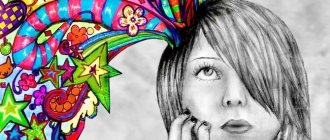Apato-abulic syndrome is a very common disorder of the emotional-volitional sphere today. The main symptom of this illness is a total lack of emotional revitalization in a person: he is completely indifferent to the events of the world around him, inactive, deliberately isolated from communication with friends and loved ones, and shows no interest in any area of life.
- Nature of the term
- Manifestations of the disease
- Causes of apato-abulic syndrome
- Symptoms of the disease
- Stages of the disease
- Diagnosis of apato-abulic syndrome
- Treatment and correction options for apato-abulic syndrome
- How to prevent the disease and what else you need to know about it
Manifestations of the disease
This disorder is most accurately characterized by the description introduced into psychiatry in 1958 - “a sharp drop in energy potential.” That is, when comparing a person’s life “before” and “after” in conversations with him and his family, the most obvious difference becomes a decrease in vital activity and a striking emotional impoverishment of the patient. However, these transformations do not occur instantly, they accumulate gradually - it is important to see the onset of changes in a person’s behavior, to seize the moment before the disorder acquires pathological proportions.
Notes
- ↑ 12Danilov D.S. Modern psychopharmacotherapeutic approaches to the correction of negative disorders in patients with schizophrenia // Review of psychiatry and medical psychology named after V. M. Bekhterev. - 2014. - No. 3. - P. 69-79.
- ↑ 12345678910N. M. Zharikov, Yu. G. Tyulpin. Psychiatry: Textbook. - M.: Medicine, 2002. - P. 152-153. — 544 p. — ISBN 5-225-04189-2.
- ↑A. S. Tiganov, A. V. Snezhnevsky, D. D. Orlovskaya, etc. Guide to psychiatry in 2 volumes / Ed. Academician of the Russian Academy of Medical Sciences A. S. Tiganov. - M.: Medicine, 1999. - T. 2. - P. 132. - 784 p. — ISBN 5-225-04394-1.
- ↑Psychiatry (Textbook for medical students). - Rostov-on-Don: Phoenix, 2002. - P. 122. - 575 p. — (Series “Higher Education”). — ISBN 5-222-02133-5.
- ↑Psychiatry (Textbook for medical students). - Rostov-on-Don: Phoenix, 2002. - P. 292. - 575 p. — (Series “Higher Education”). — ISBN 5-222-02133-5.
- ↑Reshetova T.V. Psychopharmacology for general practitioners. Methodological recommendations for doctors. - St. Petersburg: Computerburg, 2004. - P. 18. - 60 p. — ISBN 5-93463-011-3.
- ↑Ueda S, Sakayori T, Omori A, Fukuta H, Kobayashi T, Ishizaka K, Saijo T, Okubo Y. Neuroleptic-induced deficit syndrome in bipolar disorder with psychosis (English) // Neuropsychiatr Dis Treat. — 2021. — Vol. 12. - P. 265-8. — DOI:10.2147/NDT.S99577. - PMID 26893564.
- ↑Mashkovsky M.D. Medicines. — 16th ed. - M.: New Wave, 2012. - P. 128. - 1216 p. — ISBN 978-5-7864-0218-7.
- ↑Marin RS, Wilkosz PADisorders of diminished motivation // Journal of Head Trauma Rehabilitation. - 2005. - Vol. 20, no. 4. - P. 377-388.
Causes of apato-abulic syndrome
Like other mental disorders, apatho-abulsic syndrome can be caused by completely different reasons, often such factors occur at one point in time. Nevertheless, statistics report that the overwhelming number of patients with the corresponding diagnosis are teenagers aged 13-15 years, and doctors identify three main reasons for the development of the disease:
- Brain injuries: internal hemorrhages, traumatic brain injuries, tumors.
- Damage to the brain caused by exposure to various toxic substances and compounds.
- Long-term use of cannabinoids – psychoactive drugs.
- Disruption of the normal secretion of the “hormone of happiness” - dopamine, disruption of hormonal levels in general.
- Parallel course of other mental illnesses - most often this syndrome accompanies schizophrenia.
Risk factors
Abulia is a disease that is most typical for schizophrenics and people with unstable mental health. If the form of mental disorder is initial, then abulia will not be accompanied by hallucinations and delusions. But in rare cases, the development of parabulia is still possible when the patient experiences unnatural behavioral disorders, for example, exhibitionism or pedophilia.
Among the most common risk factors, experts identify:
- Post-stroke condition;
- Hypoxia;
- Severe intoxication;
- Parkinson's, Pick and Huttington's diseases;
- Malignant tumors;
- Bad habits.
Temporary manifestations of abulia usually occur as a psychogenic stupor or a reaction to serious mental trauma. Such attacks do not last long and pass immediately after the disturbing problem is resolved. In advanced cases, the condition can persist for several months or even years.
Symptoms of the disease
Among the manifestations of symptoms of the syndrome, doctors most often note the following:
- Loss of interest in entertainment and hobbies, leisure time with friends. In the initial stages of the development of the disorder, such behavior can only be noticed in free time - the patient is inactive and spends hours and days aimlessly, former hobbies are completely abandoned, new interests are not acquired. Work and study are still present in life, but mainly by inertia, without any enthusiasm or initiative. At later stages of the apato-abulic syndrome, the patient refuses these activities and often simply stops leaving the house without doing anything specific.
- Emotional burnout. This sign is characterized by a loss of the ability to empathize with loved ones - both to rejoice at their successes and to sympathize with their failures. The impoverishment of the emotional sphere leads to the patient voluntarily isolating himself from communication and refusing meetings and invitations. Moreover, quite often relationships with the closest people and those who show special care and concern even become hostile.
- Loss of social adaptation skills. In addition to indifference to his former social circle, a person gradually loses his communication abilities with strangers - when he finds himself in society, he keeps to himself, does not make contact, answers questions exclusively in monosyllables or completely ignores requests to him.
- Associated physiological manifestations: facial reactions disappear, the voice loses its “coloring” - its emotional modulations are lost, autonomic reactions such as pallor or redness are lost.
- A tendency to affective actions - that is, actions that are difficult to explain from the point of view of sound logic and were not previously inherent in the individual.
- Lack of personal hygiene. One of the most often manifested signs is that the patient loses interest in his own appearance and completely stops taking care of himself, down to basic hygiene standards. At the same time, the patient does not feel any shame or anxiety about this; his sloppiness does not evoke an emotional response in him at all.
- Transformation of speech and way of expressing thoughts. The patient’s formulations and sentences become as simple as possible, without turns or metaphors; he often expresses thoughts with gaps and interruptions for long pauses.
- Changes in motor skills. In patients with apato-abulic syndrome, the appearance of involuntary motor activities of an obsessive nature is often recorded - finger tapping, leg twitching, jerky coughing.
Autism
The concept of “autism,” according to many psychiatrists, despite repeated attempts to define the “autistic spectrum of symptoms,” remains quite vague.
It appears that autism is a complex syndrome, possibly integrating a number of manifestations of schizophrenia, including cognitive and emotional impairments, as well as behavioral changes.
According to E. Bleuler (1911), autistic thinking is divorced from reality, judgments are formed in accordance not with logic and real facts, but with the affective needs of the patient.
According to G. Benedetti (1983), autism and the primary symptoms of splitting are two sides of the same disease process. In this case, autism is interpreted by the author as a protective-compensatory reaction to splitting.
Many researchers have emphasized that autism to some extent excludes empathy.
Patients become less accessible to natural external stimuli. The surrounding world, physical reality, attracts them to a much lesser extent than their own inner world, which, according to patients, is more interesting and deep.
Autism intensifies with delirium and oneiric clouding of consciousness.
Patients strive for isolation, become withdrawn, silent, have formal contact with others, showing an indifferent attitude even towards close people. “They... go into the quiet, undisturbed world of their ghosts” (Schüle G., 1988).
Passivity is a fairly common companion to autism. The patient may not leave the house for a long time and lie in bed for a long time. Here there is a violation of social communications, a narrowing of the circle of communication and, most importantly, the need for it.
Differential diagnosis of autism symptoms in schizotypal, schizoaffective disorders and paranoid schizophrenia is presented in Table 13.
Autism syndrome includes signs of altered thinking: increased passive imagination and impaired logical reasoning. It is difficult for a patient with schizophrenia with distinct symptoms of autism to put himself in the shoes of another person, to recognize his feelings, to understand what the latter means, what meaning he puts into his words and what his intentions are.
Studies have shown that a person with schizophrenia, no matter how developed his intelligence, has difficulty understanding incorrect statements and deception.
In autism, certain intersections can be traced with the difficulty of understanding oneself, insufficient autobiographical memory, and impaired reasoning ability.
Table 13. Differential diagnosis of autism symptoms in schizotypal, schizoaffective disorders and paranoid schizophrenia
| Schizophrenia spectrum disorders | Schizotypal disorders | Schizoaffective disorders | Schizophrenia |
| Behavior | Changes in external behavior, its stereotyping | Passive submission | Ambivalent behavior |
| Social communications | Changes in social communications, isolation, unsociability, loss of interest in public life | Narrowing the circle of interests | Social isolation, isolation |
| Thinking | Violation of the adequacy of the goals set, due to switching to the world of the desired imaginary reality | Decline in creativity | Reasoning, amorphous thinking. Various forms of autistic thinking: overvalued and delusional variants, delusional fantasizing |
| Personality Features | Introversion, decreased mental flexibility and personality plasticity, rigidity | Leveling individual properties of temperament | Apathy, abulia |
| Attitude to illness | Total anosognosia | Nosognosia (shift of the disease into the past, psychologization and somatization, recognition of individual signs of the disease | Partial anosognosia |
Supporters of Z. Freud interpreted autism and decreased activity as an unsuccessful attempt at pathological compensation, “a separation from the orientation to reality.” Thus, the biological genesis of a number of manifestations of schizophrenia was denied.
According to the information theory, especially popular in the 60-70s of the twentieth century, blocking information when the brain is unable to adequately process it contributes to the emergence of autism in schizophrenia (Nuller Yu.L., 2000).
In childhood, the first descriptions of autism belong to H. Asperger (“Autistic psychopathy in childhood,” 1944) and L. Kanner (“Nervous Child,” 1943). Interest in childhood autism increased significantly after the work of L. Wing (1981). The incidence of autism is 10 per 10,000 population, Asperger's syndrome - 2 per 10,000 population. Boys get sick more often than girls, in an approximate ratio, according to ICD-10 8:1. Differential diagnosis of autism and Asperger's syndrome due to some social neglect, communication impairment, limited interests, stereotypical behavior is usually carried out with such mental disorders as obsessive-compulsive, schizoid/schizotypal personality changes, social phobia and schizophrenia.
Stages of the disease
Psychiatrists differentiate the course of apato-abulic syndrome into two stages:
- Light form. There are changes in the behavior and emotional manifestations of the patient, but they are not pathological in nature, the patient is relatively easy to involve in activities and motivate. Will, determination and emotional background return to a normal and stable state after competent complex therapy.
- Severe form. This state is characterized by a person’s categorical refusal to take any action. As a rule, by this moment absolutely all interests and motivations, besides interest in food, have been lost. In particularly critical cases, during a severe form, the patient may refuse to get out of bed even to eat.
Various forms of mental disorder
In psychology, there is a strict division between weakness of will, formed by improper upbringing, and the lack of emotional activity caused by disruption of the brain. Depending on the depth of the disease, abulia can be classified into several types:
- Light – characterized by minor deviations from the norm. The disturbances are temporary, and after an exacerbation the person may well return to normal. A short-term loss of emotional vitality and motivation does not cause significant harm to the patient.
- Severe – accompanied by a complete refusal to take any action. Distracted attention and a depressive state do not allow the sick person to perform even basic daily procedures, such as eating, washing, and cleaning.
An important characteristic of abulic disorder is the duration of the apathetic state:
- The short-term stage is usually accompanied by minor neuroses and depressive behavior.
- Periodic repetition of the apatho-abulsic state is characteristic of patients with signs of schizophrenia and drug addicts.
- Constantly being in an apathetic state forms a schizotypal brain disorder.
Apatico-abulsic syndrome is dangerous because, being in such a state, a person almost completely isolates himself from society, ignoring the norms of social behavior. His lifestyle becomes monotonous, as a result of which the disease only worsens.
Diagnosis of apato-abulic syndrome
The main problem of determining the diagnosis for apato-abulic syndrome is the absence of complaints. The patient himself is absolutely not bothered by his condition, lack of normal desires and indifference to himself and others. But, since such behavior is very noticeable from the outside, turning to a doctor in most cases occurs on the initiative and accompanied by relatives. And only persistent questioning of the doctor allows one to identify the correct diagnosis.
Also, due to the fact that usually the syndrome is not independent as a disease, but only accompanies another, underlying mental disorder, magnetic resonance imaging (MRI), computed tomography (CT), ultrasound methods, blood tests and various neurological tests are used for accurate diagnosis. .
We say abulia, we mean lack of will
From the ancient Greek language, the term “abulia” means “lack of will.” In medicine, abulia is a condition in which a pathological lack of will manifests itself.
A person may experience constant bouts of laziness, he is overcome by a feeling of indecision, lack of will, and the desire to perform certain duties that require mandatory fulfillment may completely disappear.
This pathological disorder of the nervous system is a manifestation of apathy. It is not widespread, and the disorder itself is often confused with weakness of will. Abulia is easiest to identify in an adult patient; in children, this condition is usually accompanied by various associated problems.
Treatment and correction options for apato-abulic syndrome
The patient’s path to recovery should include a set of measures from the following areas:
- drug treatment: on an individual basis, the doctor prescribes the required dosage of drugs from the group of antipsychotics: penfluridol, frenolone and triftazine;
- group therapy is the main method of involving the patient in society, resuscitating his communication skills and returning to normal life;
- family behavioral psychotherapy - begins with a clear definition of the roles of each family member and assessment of the family atmosphere; At this stage, it is important for the doctor not only to help resolve possible interpersonal conflicts, but also to convey to relatives all aspects of the patient’s illness, their manifestations and possible outcomes.
Prevention
To prevent the development of abulia, doctors advise paying attention to the person’s immediate social circle. At any age, everyone needs to feel needed and loved, because quite often malaise arises precisely because of a lack of attention and communication. Favorite hobbies play a particularly important role in the prevention of disease in adolescents.
To prevent the recurrence of the disease, it is necessary to monitor the patient’s condition and pay attention to any suspicious changes in his behavior. During exacerbations, the patient should not be left alone with himself. Psychotherapists recommend involving the sick person in work, focusing the person’s attention on the fact that he is needed and important.
How to prevent the disease and what else you need to know about it
It is obvious that, alas, there are no preventive methods for preventing apato-abulic syndrome with guaranteed effectiveness. Therefore, the main and most important thing that the patient’s relatives can do is to respond in a timely manner to changes in the behavior and lifestyle of their family member, and promptly seek qualified help from a medical institution. Here are some simple recommendations:
- Apathy, decreased vitality, short-term depressive moods are not necessarily a mental disorder. One way or another, all people are subject to emotional fluctuations due to personal events, seasonality, vitamin deficiency, stress and many other factors. But if prolonged apathy is characteristic of a person who has suffered a concussion, stroke, or other brain damage, this is a reason to be wary and vigilant.
- As noted above, the main group of patients with apato-abulic syndrome are adolescents. In a mild form of the disorder, in its initial stages, all the described symptoms rarely prompt parents and teachers to seek medical advice. As a rule, a teenager’s loss of interest in hobbies and studies, reluctance to attend school and perform household duties is attributed to a “difficult” age, the hardships of puberty, etc. Treatment is late - the disease develops.
- In adults, the syndrome is also often considered laziness in everyday life. But, as we found out above, this disease rarely occurs on its own; diagnosis is facilitated by the presence of more critical symptoms of the underlying disease.
By combining methods of treating apato-abulic syndrome under the supervision of a psychiatrist, compliance with all instructions regarding everyday communication, daily routine, visiting psychotherapeutic groups and taking medications, the patient’s relatives in the vast majority of cases note the neutralization of the changes that have occurred and a gradual return to familiar and normal life. And, although a number of doctors are inclined to argue that apato-abulic syndrome does not go away completely, but only goes into a state of remission, they do not deny that the “hibernation” of the disease can last a lifetime.
Etiology and pathogenesis of the disorder
Typically, symptoms of abulia can manifest in people with weak mental health who are prone to various somatoform disorders.
Abulic syndrome can manifest itself during disorders in the blood circulation of the right hemisphere of the brain in the frontal part. This usually occurs due to traumatic head injuries or some serious brain disease.
The pathogenesis of abulia is associated with a decrease in dopaminergic neurotransmission in the frontal lobes of the brain. These lobes are responsible for the purposeful motor functioning of the body, the ability to manifest initiative processes, systematic activity, which is aimed at performing certain functions and overcoming difficulties.
Typically, patients with disorders of the frontal part of the brain experience a state of inertia and inactivity.
Most doctors and specialists note that the main factor that provokes the manifestation of abulia is stress.
The presence of abulia leads to the deprivation of the main factor of a person’s full existence - he ceases to be a person. This is due to the fact that this disorder contributes to the disappearance of a person’s motivation, which provokes him to perform functions to achieve his cherished goal.
Such pathological spinelessness is especially dangerous in childhood. Many parents may simply not notice the presence of this disorder in their child and mistake it for a character trait - laziness, apathy, weakness of will.
The most difficult is considered to be hereditary abulia, which occurs in children from the moment of birth. Many parents are happy when their child is very calm, quiet, and sits in one place for a long time, instead of running and playing. And this condition should cause concern in parents and be the first factor for conducting an appropriate examination.
Abulia often occurs in patients with schizophrenia. People with this pathological disorder often experience a deterioration in their mental state over time, a weakening of volitional impulses is observed, an increase in passivity occurs, and they often lack the desire to perform simple and necessary actions.
The short-term onset of abulia can manifest itself as a reaction to mental trauma. This condition may not last very long; it goes away after the situation that has a traumatic effect on the psyche is resolved.
During stupor with a depressive and apathetic character, as well as during catatonic stupor, the state of abulia can develop within 2-3 months, and can last for several years.










